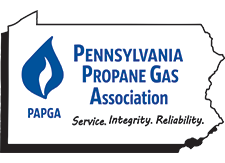What is propane?
Propane is a hydrocarbon(C3H8), also known as Liquefied Petroleum Gas or LPG, is a gas normally compressed and stored as a liquid. It is nontoxic, colorless, and virtually odorless; an identifying odor (ethyl mercaptan) is added so it can be detected. Propane is commonly used for space and water heating, for cooking, and as fuel for engine applications such as forklifts, farm irrigation engines, fleet vehicles, and buses; however, its applications are rapidly growing due to new technology developments. When used as vehicle fuel, propane is known as Propane AutoGas.
Propane is an abundant, clean-burning, domestic fuel that is a key component in Pennsylvania’s energy portfolio. Propane is an environmentally friendly clean fuel listed in the 1990 Clean Air Act as well as the National Energy Policy Act of 1992.
Where does propane come from?
Propane is primarily a byproduct of domestic natural gas processing, though some propane is produced from crude oil refinement. U.S. propane supplies are becoming increasingly abundant due in large part to increased supplies of natural gas.
- As shale gas extraction has increased, the production of propane from crude oil refinement has dropped dramatically. In 2011, 69 percent of the total U.S. supply of propane came from natural gas liquids produced in the U.S. and Canada.
- Strong growth in propane supply is expected to come from the Marcellus shale play in the northeastern U.S. Industry observers estimate the Marcellus shale alone can supply more than two billion gallons of propane per year.
- Because of the drastic increase in U.S. sources of propane, the U.S. produces more than enough propane to meet current demand and became a net exporter of propane in 2011.
Who uses propane?
Propane is used by homeowners, businesses, and organizations. Many industries are increasingly choosing propane to cost-effectively fuel vehicles and equipment while lowering emissions. Propane can be used to power a variety of applications and equipment for residential and commercial construction, on road vehicles, landscape management, material handling, and agricultural needs.
Can propane be used as the energy source in my home?
Yes. Propane is used for home heating and water heating, indoor and outdoor cooking, clothes drying, fireplaces, backup power, and outdoor living. With an all-propane home, you’ll enjoy greater efficiency and energy savings compared with all-electric homes. Propane also offers comfort, reliability, and peace of mind for your family.
Find the right energy solution for your next project by browsing the web’s largest directory of propane products.
Once you’ve selected the products you want, contact your local propane supplier to discuss purchase and next steps for installation.
How is propane distributed?
Today, the United States produces more than enough propane to go around. While propane used to be burned away as part of oil refining, it’s now captured and used as clean, American energy. In fact, propane is one of the cleanest fuels out there, and it’s an EPA-certified alternative clean energy.
After it leaves the processing plant, propane is stored as liquid underground until it’s needed. Then it travels around the country through a network of pipelines, railroad tank cars, tractor-trailers, and barges. Along the way, it creates about 80,000 American jobs. From regional storage sites nationwide, the propane is then sent to distributors, like your supplier.
Finally, propane is pumped into bobtail delivery trucks that deliver it to millions of American homes and businesses.
How does the propane industry in Pennsylvania contribute to the economy?
Propane has been a part of America’s energy mix for more than 100 years. The propane industry contributes nearly $1.8 million a year to Pennsylvania’s economy, and providing more than 2,600 jobs throughout the Commonwealth. Furthermore, we supply propane to almost 215 thousand homes in Pennsylvania that choose propane as their energy source in home heating. Propane is a versatile fuel and is most commonly used in home comfort equipment such as furnaces, water heaters, clothes dryers, fireplaces, grills, stoves, pool heating, space heating, and more. When used for engine applications, such as forklifts, mowers, generators, irrigation engines and even on-road vehicles, propane is known as AutoGas. Propane applications are continually growing due to new technology developments.
How much propane is produced in Pennsylvania*?
Pennsylvania produced 245 million gallons of odorized propane in 2018, 2.84% of the U.S. total. Gas processing plants produced approximately 201 million gallons and refineries produced 44 million gallons. The total market value of odorized propane sold in the state in 2018 was $842 million, and the propane industry’s total contribution to state GDP was $1.756 million.

 Mower Equipment
Mower Equipment